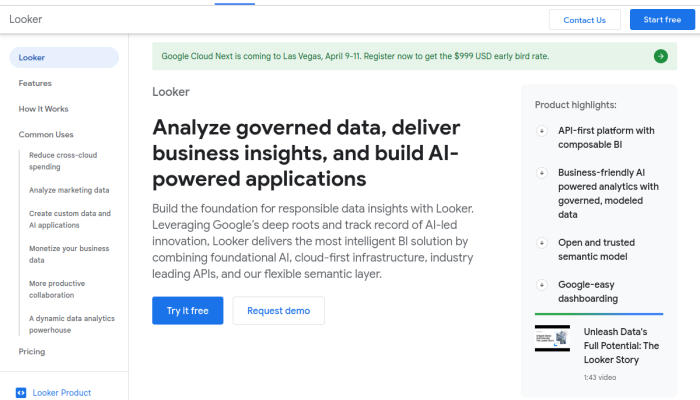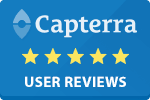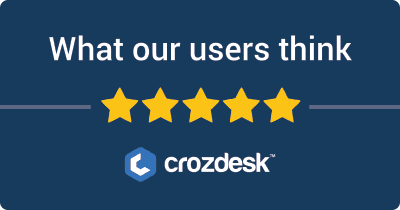
Introduction: Tableau vs. Looker in Analytics Tools
Tableau and Looker are two leading analytics tools that empower organizations to visualize and analyze data for informed decision-making. Tableau is primarily recognized for its powerful data visualization capabilities, allowing users to create intricate graphs and interactive dashboards. Looker, on the other hand, stands out for its data modeling capabilities and integration with modern cloud data warehouses, enabling organizations to delve deeper into their data and derive actionable insights.
Users commonly choose these tools for their robust analytics features, ability to foster data-driven cultures, and strong community support. Businesses often seek Tableau for its rich visual storytelling capabilities, while Looker is favored for its flexibility in querying data through a more analytical approach.
Key aspects for comparison include:
- Features: An evaluation of visualization capabilities, data modeling options, and integration ease.
- Pricing: A breakdown of cost structures, licensing models, and overall value for money.
- Ease of Use: An assessment of user-friendliness, learning curve, and accessibility for business users versus technical analysts.
This concise comparison aims to assist potential users in selecting the right analytics tool to meet their needs.
Tableau VS Looker: Which tool is the most popular?
| Tool | Number of Reviews | Average Rating | Positive Reviews | Neutral Reviews | Negative Reviews |
|---|---|---|---|---|---|
| Looker | 20 | 4.5 | 19 | 1 | 0 |
| Tableau | 21 | 3 | 12 | 1 | 8 |
Looker stands out as the most popular tool due to its higher average rating of 4.5 with 19 positive reviews and no negative feedback. Tableau, while having more reviews at 21, has a lower average rating of 3, indicating a less favorable reception with 8 negative reviews.


Tableau and Looker: Quick Comparison Overview
| Feature/Aspect | Ahrefs | SEMrush |
|---|---|---|
| Primary Features | – Site Explorer – Keyword Explorer – Backlink Checker – Content Explorer – Rank Tracker |
– Keyword Research – Site Audit – Position Tracking – Content Analyzer – Marketing Insights |
| Target Audience | – SEO professionals – Digital marketers – Agencies focusing on content marketing and backlink analysis |
– Digital marketers – SEO experts – Content marketers – Social media marketers and PPC specialists |
| Main Advantages | – Robust backlink analysis – Comprehensive keyword data – Intuitive user interface – Constantly updated index |
– All-in-one digital marketing tool – Extensive competitor analysis – Wide array of tools for SEO and PPC – Integrated social media management |
| Core Value Proposition | Focused on providing in-depth SEO insights, particularly strengths in backlink profiles and organic keyword rankings. Ideal for users prioritizing content strategy and link-building efforts. | Offers a holistic view of digital marketing, making it easier to manage all aspects of online presence through an extensive range of tools for SEO, PPC, and social media marketing. |
| Ideal Use Cases | – Conducting comprehensive link audits – Developing effective content strategies – Tracking backlinks and organic rankings – Keyword planning for SEO campaigns |
– Managing and optimizing PPC campaigns – Conducting competitive analysis for market positioning – Comprehensive content analytics and SEO tracking – Social media metrics and management |
Most liked vs most disliked features of Tableau and Looker
| Tool | Most Liked Features | Most Disliked Features |
|---|---|---|
| Tableau | – Fast and responsive nature of the tool. | – Considered expensive, particularly for smaller budgets. |
| – Consistent performance, crucial for data-driven decisions. | – Interface perceived as not intuitive or challenging for new users. | |
| Looker | – Simplifies navigation and report creation, enhancing accessibility for all users. | – New users may find navigation daunting, hindering full utilization. |
| – Effective tools for clear and informative dashboard creation, aiding in data insights presentation. | – Reports of lags or freezing when working with complex datasets. | |
| – Seamless integration with Google tools, enhancing workflow efficiency. | – Lack of robust data transformation capabilities limits data manipulation before visualization. | |
| – Customizable dashboards and reports to meet specific needs and client requirements. | – Some interface elements appear simplistic and may lack advanced features compared to competitors. | |
| – Automatic data importing ensures up-to-date reporting, aiding timely business decisions. | – Challenges in setting up and connecting data sources can be time-consuming and not straightforward. |
Key Features of Tableau vs Looker
Key Features of Tableau and Looker for Analytics Tools
Tableau
-
Data Visualization
- Benefit: Tableau offers a wide range of visualization options, including interactive dashboards, data charts, maps, and more. Users can easily create and customize visualizations to effectively communicate insights.
- Unique Aspect: Tableau emphasizes user-friendly drag-and-drop features, allowing users to visualize data without needing extensive programming knowledge.
-
Data Connectivity
- Benefit: Tableau can connect to various data sources, including cloud databases, spreadsheets, and web data connectors. This flexibility allows users to analyze data from multiple platforms in one place.
- Unique Aspect: It supports live and extract connections, enabling real-time data analysis or scheduled updates depending on user requirements.
-
User-Friendly Interface
- Benefit: Tableau’s interface is designed for ease of use, allowing both technical and non-technical users to build complex analytics without steep learning curves.
- Unique Aspect: Guided analytics feature lets users interactively explore data, suggesting the best visualization types based on the selected data.
-
Collaboration Tools
- Benefit: With functionality for team sharing, commenting, and real-time collaboration, Tableau enhances teamwork. Users can publish dashboards to Tableau Server or Tableau Online for collective access.
- Unique Aspect: Tableau’s “Ask Data” feature uses natural language processing, allowing users to ask questions in plain language and receive immediate visual responses.
-
Mobile Compatibility
- Benefit: Tableau’s mobile app allows users to access dashboards and analyze data on the go, making insights available anytime, anywhere.
- Unique Aspect: The mobile interface is optimized for touch, ensuring that users have a seamless experience, regardless of device.
Looker
-
Data Model Layer (LookML)
- Benefit: Looker’s unique modeling layer allows data analysts to define and manage the relationships in their data, simplifying analytics and enabling consistent data usage across the organization.
- Unique Aspect: LookML allows for reusability of metrics and definitions, promoting a single source of truth for all users.
-
Embedded Analytics
- Benefit: Looker provides the capability to embed analytics and visualizations directly into applications, enabling organizations to integrate insights into their existing workflows.
- Unique Aspect: Embedded analytics can be customized extensively, which allows companies to tailor the experience to their users’ needs seamlessly.
-
Ad-Hoc Analysis
- Benefit: Looker features powerful ad-hoc query capabilities, enabling users to explore and analyze data on demand without needing extensive technical skills.
- Unique Aspect: The ability to create custom reports and dashboards through a self-service interface allows users to tailor their analytics without always relying on data teams.
-
Collaboration and Sharing
- Benefit: Looker facilitates team collaboration through features allowing users to share insights, comments, and schedule reports with ease.
- Unique Aspect: The “Slack integration” enables sharing insights directly in team communication channels, enhancing responsiveness and team engagement.
-
Integration with Modern Data Stack
- Benefit: Looker seamlessly integrates with modern data technologies such as data warehouses and cloud services, allowing for a smoother data pipeline and more streamlined analytics.
- Unique Aspect: Its architecture allows for leveraging SQL databases directly, providing users with better performance when querying large datasets.
Summary
Both Tableau and Looker offer robust analytics tools tailored to different user needs. Tableau excels in data visualization and intuitive user experience, making it accessible for users at all levels. Looker stands out with its strong data modeling capabilities and embedded analytics options, catering particularly to businesses looking for deeper integration of analytics within their operations. The choice between the two depends largely on the specific analytics needs, technical expertise of users, and the desired degree of customization.
Tableau vs Looker Pricing Comparison
| Feature/Brand | Tableau Pricing | Looker Pricing |
|---|---|---|
| Pricing Tiers | – Tableau Creator – Tableau Explorer – Tableau Viewer |
– Looker (basic plan only, pricing upon request) |
| Monthly Subscription | – Creator: $70/user – Explorer: $42/user – Viewer: $12/user |
Pricing is custom and typically requires consultation |
| Annual Subscription | – Creator: $840/user – Explorer: $504/user – Viewer: $144/user |
Typically around $72,000/year for a basic package (custom pricing applies) |
| Main Features | – Creator: Full capabilities, data preparation, dashboards, and analytics – Explorer: Limited to visualization and dashboard editing, requires a Creator to publish dashboards – Viewer: Read-only access to dashboards and reports |
– Standard analytics, embedded analytics, and data modeling features included in all tiers |
| Free Trial | – 14-day free trial available for each tier | – 14-day free trial available only upon request |
| Discounts/Special Rates | – Educational discounts available – Non-profit discounts available |
– Custom discounts may be available based on volume and negotiation |
Main Differences in Offerings:
- Tableau offers distinct tiers that cater to different user needs, with features scaling from full data experience at the Creator level to basic viewing rights at the Viewer level.
- Looker primarily operates on a custom pricing model, meaning specific offerings can vary widely based on the organization’s needs.
- Looker does not provide a clear tier differentiation like Tableau, which may complicate direct feature matching.
This comparison highlights the structured pricing of Tableau and the flexible, customized approach of Looker, enabling users to assess which platform aligns better with their analytical needs and budget considerations.
Support Options Comparison: Tableau vs Looker
| Support Option | Tableau | Looker |
|---|---|---|
| Live Chat | Available for all users during business hours. | Offered for standard support users; available 6 AM to 6 PM PT, Monday to Friday. |
| Phone Support | Access to phone support is available for customers with a maintenance plan; hours vary by region. | Phone support is primarily for enterprise users; hours are 6 AM to 6 PM PT, Monday to Friday. |
| Documentation | Comprehensive documentation with user guides, API references, and FAQs available online. | Extensive documentation provided, covering features, setup, and troubleshooting. |
| Webinars/Tutorials | Offers live and recorded webinars, training sessions, and a dedicated e-learning platform. | Provides webinars and training resources, including live and on-demand options focused on user engagement. |
| Community Support | Access to user community forums for peer support and knowledge exchange. | Active community forum where users can ask questions and share best practices. |
| Support Plans | Multiple tiers including Standard and Premium packages, offering varied levels of support. | Standard and Premium support options available, with different response times and features. |
Unique Features of Tableau Vs Looker
| Feature | Tableau | Looker | Added Value and Decision Factors |
|---|---|---|---|
| Visual Analytics | Interactive dashboards with drag-and-drop functionality | Embedded analytics within applications | Tableau’s user-friendly interface allows users to create complex visualizations easily, enhancing data storytelling. Looker’s integration fosters seamless data access in existing apps, promoting data-driven culture in organizations. |
| Data Blending | Combine data from different sources in one visualization | Model-based approach for data exploration | Tableau’s ability to blend multiple data sources enhances comprehensive analysis. Looker’s modeling layer allows users to explore data using consistent definitions, ensuring accuracy and alignment across teams. |
| Live Connection | Connects directly to databases, enabling real-time data analysis | LookML for data modeling | Tableau’s live connection feature ensures up-to-date insights at any moment. LookML allows users to define metrics and dimensions centrally, reducing redundancy and errors in reporting. |
| Advanced Analytics | Offers built-in predictive analytics and AI capabilities | Strong support for data governance and security | Tableau’s predictive capabilities empower users with proactivity in data insights. Looker’s focus on data governance enhances compliance and trust in data-driven decisions, especially for enterprises. |
| Extensibility | Rich ecosystem of integrations and API access | Data blocks for reusable metrics and definitions | Tableau’s extensive integration options create flexibility and customization in enterprise environments. Looker’s reusable data blocks streamline workflows and improve efficiency by minimizing redundant efforts. |
| Collaboration | Shared dashboards and easy report sharing | Scheduled reports and alerts | Tableau facilitates collaboration through sharing insights easily. Looker enhances team interaction through automated reports and alerts, improving proactive data engagement among stakeholders. |
| Mobile Access | Mobile dashboards with responsive design | Mobile-friendly interface with secure access | Tableau’s mobile capabilities enable on-the-go access for decision-makers. Looker’s mobile interface ensures data access remains secure and usable, which is pivotal for organizations prioritizing mobile analytics. |
These unique features of Tableau and Looker distinguish them from conventional analytics tools by emphasizing user experience, data accuracy, and collaboration, which can be crucial in a competitive business landscape.


